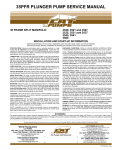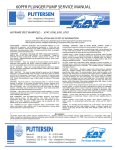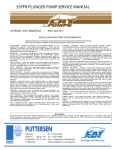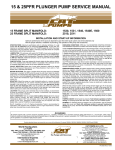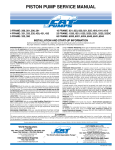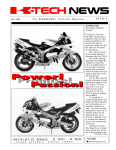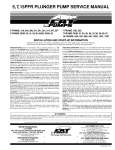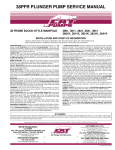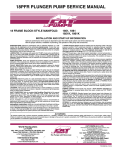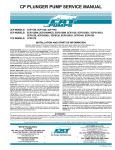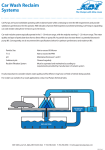Download 35PFR PLUNGER PUMP SERVICE MANUAL
Transcript
35PFR PLUNGER PUMP SERVICE MANUAL 35 FRAME SPLIT MANIFOLD : 3520, 3521 and 3527 3535, 3531 and 3537 3545, 3541 3560 INSTALLATION AND START-UP INFORMATION Optimum performance of the pump is dependent upon the entire liquid system and will be obtained only with the proper selection, installation of plumbing and operation of the pump and accessories. SPECIFICATIONS : Maximum specifications refer to individual attributes. It is no t implied that all maximums can be performed simultaneousl y. If more than one maximum is considered, check with your CAT PUMP S supplier to confirm the proper performance and pump selection. Refer to individual pump Data Sheets for complete specifications, parts list and exploded view. DISCHARGE CONDITIONS: OPEN ALL VALVES BEFORE STARTING SYSTEM to avoid deadhead overpressure condition and severe damage to the pump or system . LUBRICATION: Fill crankcase with special CAT PUMP oil per pump specifications (4.2 Qts. - 4.0 L). DO NOT RUN PUMP WITHOUT OIL IN CRANKCASE. Change initial fill after 50 hours running period. Thereafter, change oil every 3 months or 500 ho ur in terv al s. Oil er adju s tment is vertical to s tart feed, horizontal to s top feed, dial to adjust flow rate. Additional lubrication may be required with increased hours of operation and temperature. A reliable Pressur e Gauge should be installed near the discharge outlet of the high pressure manifold. This is extremely important for adjusting pressure regulating device s and also for proper sizing of the nozzle or restricting orifice. The pump is rated for a maximum pressure; this is the pressur e which would be read at the discharg e manifold of the pump , NOT AT THE GUN OR NOZZLE. PUMP ROTATION: Pump was designed for forward rotation to allow optimum lubrication of the cros sh ea d area. Rev erse rotation is acc eptable if the crankcas e oil level is increased slightly above center dot to assure adequate lubrication. PULLEY SELECTION : Select size of motor pulley required to deliver the desired flow from Horsepower Requirement and Pulley Selection Chart (refer to Tech Bulletin 003) . DRIVE SELECTION: The motor or engine driving the pump must be of adequate horsepower to maintain full RPM when the pump is under load. Select the electric motor from the Horsepower Requirement Chart according to required pump discharg e flow, maximum pressure at the pum p and drive losses of approximately 3-5% . Co nsult the manufacturer of gas or diesel engine for selection of the proper engine size. MOUNTING: Mount the pump on a rigid, horizontal surface in a manner to permit drainage of crankcase oil. An uneven mounting surface will cause extensive damag e to the pump bas e. T o minimize piping s tres s, us e appro pri ate flexible hos e to inlet and discharge port s . Use the correct belt; make sure pulleys are aligned. Excessive belt tension may be harmful to the bearings. Hand rotate pump before starting to be certain shaft and bearings are free moving. LOCATION: If the pump is used in extremely dirty or humid conditions, it is reco mmended pump be enclosed. Do not store or operate in excessively high temperature areas or without proper ventilation. INLET CONDITIONS: Refer to complete Inlet Condition Check-List in this manual before starting system. DO NOT STARVE THE PUMP OR RUN DRY . Temperatures above 130°F are permissible. Add 1/2 PSI inlet pressure per eac h degree F over 130°F. Elastomer or RPM changes may be required. See Tec h Bulletin 002 or call CAT PUMPS for recommendations. C. A .T. : Ins tallation of a C .A .T. (C aptive Acc eleration T ube) is recommended in applications with stressful inlet conditions such as high temperatures, booster pump feed, long inlet lines or quick closing valves. Install a Pulsation Dampening device on the discharge head or in the discharge line as close to the head as possible. Be certain the pulsation dampener (Prrrrr-o-lator ) is properly precharged for the system pressure (see individual Data Sheet). Use PTFE thread tape or pipe thread sealant (sparingly) to connect accessories or plumbing. Exercise caution not to wrap tape beyond the last thread to avoid tape from becoming lodged in the pump or accessories. This condition will cause a malfunction of the pump or system . PRESSURE REGULATION: All systems require both a primary pressure regulating device (i.e., regulator, unloader) and a secondary pressure safety relief device (i.e., pop-off valve, safety valve). The primary pressure device must be installed on the discharge side of the pump. The function of the primary pressure regulating device is to protect the pump from over pressurization, which can be caused by a plugged or closed off discharge line. Over pressurization can severely damage the pump, other system components and can cause bodily harm. The secondary safety relief device must be installed in-line between the primary device and pump or on the opposite side of the manifold head . This will ensure pressure relief of the system if the primary regulating device fails. Failure to install such a safely device will void the warranty on the pump. If a large portion of the pumped liquid is by-passed (not used) when the high pressur e system is running, this by-pass liquid should be routed to an adequately sized, baffled supply tank or to drain. If routed to the pump inlet, the by-pass liquid can quickly develop excessive heat and result in damage to the pump. A temperature control device to shut the system down within the pump limits or multiple THERM O VALVES must be installed in the by-pass line to protect the pump. NOZZLES : A worn nozzle will result in loss of pressure. Do not adjust pressure regulating device to compensate. Replace nozzle and reset regulating device to system pressure . PUMPED LIQUIDS : Some liquids may require a flush between operations or befor e storing . For pumping liquids other than water, contact your CA T PUMP S supplier. STORING: For extended storing or between use in cold climates, drain all pumped liquids from pump and flush with antifreeze solution to prevent freezing an d damage to the pump. DO NOT RUN PUMP WITH FROZEN LIQUID (refer to Tech Bulletin 083). WARNING All systems require both a primary pressure regulating device (i.e., regulator, unloader) and a secondary pressure safety relief device (i.e., pop-off valve, safety valve). Failure to install such relief devices could result in personal injury or damage to the pump or to system components. CAT PUMP S does not assume any liability or responsibilit y for the operation of a customer’s high pressure system . Pijttersen B.V. Tel.: +31 (0)513-414040 Postbus 262, 8500 AG Joure Fax: +31 (0)513-414066 Transportwei 26, 8501 ZP Joure E-mail : [email protected] / [email protected] The Netherlands Internet : www.pijttersen.nl / www.catpumps.nl All models except 3560 Removal of Discharge Valve Plug All models except 3560 Discharge Valve Assembly 3560 Stacked Inlet/Discharge Valve Design CAUTION: Before commencing with service, shut off drive (electric motor, gas or diesel engine) and turn off water supply to pump. Relieve all discharge line pressure by triggering gun or opening valve in discharge line. After servicing is completed, turn on water supply to pump, start drive, reset pressure regulating device and secondary valve, read system pressure on the gauge at the pump head. Check for any leaks, vibration or pressure fluctuations and resume operation. SERVICING THE VALVES Disassembly (All models except 3560) 1. Remove the six (6) M41 Hex Valve Plugs. 2. Remove the exposed Coil Spring from the top of the Spring Retainer. Thread an M10 bolt into the top of the Spring Retainer. The assembly will usually remain together. To separate, continue threading the bolt into the back side of the Valve Seat until it separates from the Spring Retainer. In all models if the assembly separates during removal, use a valve seat removal tool and lift the Seats from the chamber. Disassembly (Model 3560) NOTE: The Discharge and Inlet Valve assemblies are a stacked design and are both accessible by removing the valve plugs. Follow the same procedure for inlet and discharge assemblies. NOTE: The Discharge and Inlet Valve assemblies may stay together or separate during removal. NOTE: Spring Retainer may also separate from Valve Seat during removal. 1. Using an M12 Allen wrench remove the (4) four hex socket head screws (HSH) from each valve plug. Remove Valve Plugs with O-Ring and Back-up-Ring from the Discharge Manifold chambers. 2. Using a reverse pliers, pull the stacked valve assemblies from the valve chamber. 3. If the Inlet Valve Assembly stays in the manifold, use a reverse pliers to remove it. 4. If the seat separates from the discharge or inlet assembly, insert the reverse pliers into the I.D. of the seat and remove it. All models except 3560 Removal of Discharge Manifold Screws Reassembly (All models except 3560) NOTE: For certain applications apply liquid gasket to the o-ring crevices and seal surfaces. See Tech Bulletin 053 for model identification. 1. Examine the O-Rings and Back-up-Rings on the Seat and replace if cut or worn. Lubricate the O-Ring before installing. 2. Examine the surface of the Valve and Seat for pitting, grooves or wear and replace if necessary. 3. Assemble Valve Retainer, Spring, Valve and Seat by snapping together securely. Thread the M10 bolt into spring retainer for installation. 4. Lubricate outer O-Ring and Back-up-Ring surface and walls of valve chamber and press Valve Assembly squarely into chamber. Remove M10 bolt. Place the washer over the top of the Spring Retainer and then the Coil Spring on top of the Washer. 5. Examine the O-Ring and Back-up-Ring on the Valve Plug and replace if cut or worn. Lubricate new O-Ring and Back-up-Ring before installing onto Valve Plug. Exercise caution to avoid damage from the valve plug threads. NOTE: The Back-up-Ring is installed first, then the O-Ring. 6. Slowly thread the Valve Plug into chamber. Exercise caution to avoid extruding or cutting the Back-up-Ring or O-Ring. Then torque to specifications. NOTE: It is highly recommended that anti-seize lubricant (PN6119) be applied to the threads of all stainless steel components to prevent galling. NOTE: Apply Loctite 242 to the threads of the Valve Plug (brass models) before threading into the valve chamber. All models except 3560 Removal of Discharge Manifold Removal of Inlet Screws and Inlet Manifold Removal of Inlet Manifold O-Rings 3531, 3535, 3537, 3541, 3545, 3650 Removal of V-Packing Spacer from Inlet Manifold Reassembly (Model 3560) NOTE: For certain applications apply liquid gasket to the o-ring crevices and seal surfaces. See Tech Bulletin 053 for model identification. 1. Examine the O-Ring on the Inlet Seat and replace if cut or worn. 2. Examine Inlet Valves and Seats for grooves, pitting or wear and replace as needed. 3. Examine Inlet Springs for fatigue or breaks and replace as needed. 4. Examine Inlet Spring Retainers for internal wear or breaks in the structure and replace as needed. 5. Examine the O-Rings and Back-up-Rings on the Discharge Seat and replace if cut or worn. 6. Examine Discharge Valves and Seats for grooves, pitting or wear and replace as needed. 7. Examine Discharge Springs for fatigue or breaks and replace as needed. 8. Examine Discharge Spring Retainers for internal wear or breaks in the structure and replace as needed. NOTE: Inlet Valve Seat and O-Ring are different from the Discharge Valve Seat, O-Ring and Back-up-Ring. One Valve Kit required per pump. 9. Lubricate and install new O-Ring onto each Inlet Seat. 10. Place Inlet Seat on work surface with small diameter side up. 11. Place the Valve onto Inlet Seat with concave side down. 12. Place Spring on Valve. 13. Install Inlet Spring Retainer with deep stepped end over Spring and snap onto Inlet seat. 14. Lubricate and install O-Ring, then Back-up-Ring onto the Discharge Seats. 15. Place Discharge Seat on a work surface with small diameter down. 16. Place Valve onto Discharge Seat with the concave side down. 17. Place Spring on Valve. 3531, 3535, 3537, 3541, 3545 V-Packing and Spacer Arrangement 3520, 3521, 3527 Removal of V-Packing Cylinder 18. Install Discharge Spring Retainer with deep stepped end over Spring and snap onto Discharge Seat. 19. Complete the stacked assembly by pressing the Discharge Valve Assembly into the Inlet Valve Assembly. 20. Place the complete stacked valve assembly into each Valve Chamber until completely seated. 21. Lubricate and install Back-up-Ring, then O-Ring onto each Valve Plug. Press Valve Plug into each Valve Chamber. Exercise caution to avoid damage from the valve plug threads. 22. Apply anti-seize lubricant (PN6119) to HSH screw threads and thread in hand tight. Torque to specifications in torque chart. REMOVING THE DISCHARGE MANIFOLD 1. Remove the eight (8) HSH screws. 2. Tap the back side of the Discharge Manifold with a soft mallet and gradually work head from pump. 3. Remove the O-Rings from lower chambers of the face of the Inlet Manifold. REMOVING THE INLET MANIFOLD 1. Using a hex allen wrench, remove the four (4) HSH screws. Rotate the Crankshaft to begin the separation of the Inlet Manifold from the Crankcase. 2. Tap the rear of the Inlet Manifold with a soft mallet and gradually work from pump. NOTE: Support from the underside and exercise caution to keep manifold aligned with Plungers to avoid damage to the Plungers as the manifold is removed. NOTE: Two screwdrivers on opposite sides of the manifold may be used to assist separation. 3520, 3521, 3527 V-Packing and Cylinder Arrangement 3560 V-Packing-Spacer Arrangement 3531, 3535, 3537, 3541, 3545 V-Packing Spacer and Spacer with Coil Springs Removal of Lo-Pressure Seal from Inlet Manifold SERVICING THE SEALS Disassembly of the V-Packings 1. Place the crankcase side of the Inlet Manifold down on the work surface. 2. Remove the V-Packing Spacer. These may stay in either the Inlet or Discharge Manifold ports when the Discharge Manifold is removed. If they are extremely dirty or dry, remove the exposed O-Ring and Back-up-Ring and insert two screwdrivers on opposite sides to pry out of chamber. 3. Examine both front and rear O-Rings and Back-up-Rings on the V-Packing Spacer for cuts or wear and replace as needed. NOTE: The 3545, 3541 do not have Back-up-Rings. 4. Remove V-Packing Cylinder (3520, 3521, 3527), by inserting two screwdrivers on opposite sides of the V-Packing Cylinder and pry out. Examine O-Ring for wear and replace as needed. 5. Remove Spacer with Coil Springs (except 3560). Examine for broken or fatigued springs or scale build up or pitting and replace as needed. 6. With a reverse pliers remove Male Adapter, V-Packings and Female Adapter. NOTE: Using the reverse pliers may damage V-Packings or Female Adapter. 7. Examine Female Adapter for worn I.D. and replace as needed. Reassembly of the V-Packings NOTE: For certain applications apply liquid gasket to the o-ring crevices and seal surfaces. See Tech Bulletin 053 for model identification. 1. Lubricate outer surface of V-Packing Cylinder and install new O-Ring in groove (3520, 3521, 3527). Press V-Packing Cylinder with O-Ring end down into the manifold chamber until completely seated. 2. Insert Female Adapter into V-Packing Cylinder (3520, 3521, 3527) or manifold chamber (3535, 3531, 3537, 3545, 3541, 3560) with the “V” groove up. 3. Fit the new V-Packings together, lubricate outer surface of the packings and insert into V-Packing Cylinder (3520, 3521, 3527) or manifold chamber (3535, 3531, 3537, 3545, 3541, 3560) with the “V” groove up. 4. Install Male Adapter into V-Packing Cylinder (3520, 3521, 3527) or manifold chamber (3535, 3531, 3537, 3545, 3541, 3560) with the “V” groove down (notches up). 5. Lubricate outer surface of Spacer with Coil Springs and insert into V-Packing Cylinder (3520, 3521, 3527) or manifold chamber (3535, 3531, 3537, 3545, 3541) with springs facing down. See Tech Bulletin 050 when servicing old style pumps; both the spacer with coil springs and inlet manifold must be updated. 6. Lubricate outer surface of V-Packing Spacer, install new O-Rings and Back-up- Rings in both front and rear groove and press into V-Packing Cylinder (3520, 3521, 3527) or manifold chamber (3535, 3531, 3537, 3560) with small diameter down until completely seated. NOTE: The 3545, 3541 do not have Back-up-Rings. 3531, 3535, 3537, 3541, 3545 Lo-Pressure Seal and Washer Assembly Disassembly of the Lo-Pressure Seal 1. With the Inlet Manifold on blocks and with the crankcase side down, insert screwdriver into seal chamber and tap opposite sides of the Washer Spacer to drive out seal assembly. NOTE: Models 3535, 3531, 3537, 3545, 3541 include Spacer and Lo-Pressure Seal. Models 3520, 3521, 3527 include Washer, Lo-Pressure Seal, Inlet Adapter and O-Ring. Model 3560 includes only LPS. 2. Elevate Inlet Adapter with Lo-Pressure Seal down and tap with screwdriver on opposite sides of seal to drive seal out of Inlet Adapter (Models 3520, 3521, 3527 only). Replace the Lo-Pressure Seal and examine Inlet Adapter O-Ring for wear and replace as needed. Reassembly of the Lo-Pressure Seal NOTE: For certain applications apply liquid gasket to the o-ring crevices and seal surfaces. See Tech Bulletin 053 for model identification. Models 3535, 3531, 3537 1. With the crankcase side of Inlet Manifold up insert the LPS Spacer into the seal chamber. 2. Install Lo-Pressure Seal into seal chamber with garter spring facing down and press squarely into position. Models 3520, 3521, 3527 1. With the crankcase side of Inlet Manifold up insert the Washer into the seal chamber. 2. Install Lo-Pressure Seal into larger diameter of Inlet Adapter with spring up and press squarely into position. 3. Lubricate outer surface of Inlet Adapter and install O-Ring into the groove of the Inlet Adapter. 4. Press Inlet Adapter with seal into seal chamber with garter spring facing down. Models 3545, 3541 1. With the crankcase side of the Inlet Manifold up insert the LoPressure Seal into the seal chamber with the garter spring facing down and press squarely into position. NOTE: Install the LPS Spacer onto the plunger in front of the Seal Retainer and not in the I.M. seal chamber. Models 3560 1. With the crankcase side of the Inlet Manifold up insert the LoPressure Seal into the seal chamber with the garter spring facing down and press squarely into position. 3560 Lo-Pressure Seal 3520, 3521, 3527 Lo-Pressure Seal and Adapter Assembly SERVICING THE PLUNGERS Disassembly 1. To service the plungers it is necessary to remove the Discharge and Inlet Manifolds. Follow the disassembly procedure found under REMOVING THE DISCHARGE MANIFOLD and REMOVING THE INLET MANIFOLD. 2. Remove the Seal Retainers from the Ceramic Plungers. 3. Remove the Inner Collar from the front of the seal retainer. 4. Remove the used Wick and install new Wick. NOTE: Model 3545, 3541 do not have Wicks or front half of Seal Retainer. 5. Replace Inner Collar on Seal Retainer. 6. Loosen Plunger Retainer 4 to 5 turns. Push Plunger towards Crankcase until Plunger Retainer pops out. 7. Unscrew and remove Plunger Retainer, Gasket, O-Ring, Back-upRing and Ceramic Plunger, Keyhole Washer and Barrier Slinger from each Plunger Rod. Reassembly 1. With these plunger items removed, examine the Crankcase Oil Seal for wear or deterioration and replace as needed. 2. Replace Keyhole Washer on Plunger Rod. 3. Carefully examine each Plunger for scoring or cracks and replace if worn. NOTE: Ceramic Plunger can only be installed one direction (front to back). Do not force onto rod. 4. Examine Gasket, O-Ring and Back-up-Ring on Plunger Retainer and replace if cut or worn. Lubricate O-Ring for ease of installation and to avoid damaging O-Rings. NOTE: First install Gasket, then O-Ring and Back-up-Ring. 5. Apply loctite 242 to the threads of the Plunger Retainer and thread Plunger Retainer onto Plunger Rod. Torque per specifications. 6. Slip Seal Retainers over Plungers. NOTE: On Model 3545, 3541 install LPS Spacer over plungers until flush with Seal Retainer. Line up Wicks with the oil holes in the Crankcase and tabs in the Oil Pan (3520, 3521, 3527, 3535, 3531, 3537). 7. Rotate crankshaft by hand so the two outside Plungers are extended equally. 8. Lubricate the Plungers. 9. Carefully replace Inlet Manifold onto Plungers and press into Crankcase. Keep manifold aligned to avoid damaging Plungers. 10. Replace four (4) HSH screws and torque per chart. 11. Examine inlet port o-rings at bottom of manifold and replace if cut or worn. Wick lubrication: Oiler setting for Wicks is three drops per hole, twice per month for normal operation. Oiler adjustment is vertical to start feed, horizontal to stop feed, 45° to flush bearing. Additional lubrication may be required with increased hours of operation and temperature. NOTE: Do not lubricate wicks at initial start-up. Operate for 10 to 15 minutes to allow grease from LPS to penetrate the plunger surface, then lubricate as needed. Plunger Arrangement 12. Lubricate outer surface of V-Packing Spacer, O-Rings and valve chamber walls and carefully slip Discharge Manifold over V-Packing Spacer. 13. Hand tighten the two (2) HSH screws first. Then hand tighten the remaining six (6) HSH screws. Torque per chart and in this sequence. 1 3 5 7 8 6 4 2 SERVICING THE CRANKCASE SECTION 1. While manifolds, plungers and seal retainers are removed examine crankcase oil seals for leaking and wear. 2. Check for signs of leaking at Bearing Covers, Rear Cover, Drain Plug, and Bubble Oil Gauge. 3. Check oil level and for evidence of water in oil. Change crankcase oil on a regular schedule. See Preventative Maintenance Check-List. 4. Rotate Crankshaft by hand to feel for smooth bearing movement. 5. Examine Crankshaft Oil Seals externally for drying, cracking or leaking. 6. Contact CAT PUMPS or your local distributor if crankcase service is required. See Tech Bulletin 035. See section III of the Plunger Pump Service Video for additional information (except 3560). INLET CONDITION CHECK-LIST PREVENTATIVE MAINTENANCE CHECK-LIST Check Clean Filters Oil Level/Quality Oil Leaks Water Leaks Belts, Pulley Plumbing Initial Oil Change Oil Change Seal Change Valve Change Accessories Daily Weekly 50 hrs. 500 hrs.* 1500 hrs.** 3000 hrs.** x x x x x x x x x x x * If other than CAT PUMPS special multi-viscosity ISO68 oil is used, change cycle should be every 300 hours. ** Each system’s maintenance cycle will be exclusive. If system performance decreases, check immediately. If no wear at 1500 hours, check again at 2000 hours and each 500 hours until wear is observed. Valves typically require changing every other seal change. Duty cycle, temperature, quality of pumped liquid and inlet feed conditions all effect the life of pump wear parts and service cycle. ** Remember to service the regulator/unloader at each seal servicing and check all system accessories and connections before resuming operation. Refer to video for additional assistance. TORQUE CHART Pump Item Thread Tool Size [Part No.] Torque in. lbs. ft. lbs. Nm Plunger Retainer Model 3560 Only M10 M7 M21 Hex M14 Hex [25053] 220 90 18.0 7.5 24 10 Inlet Manifold Screws M14 M12 Allen [33048] 480 40.0 54 Discharge Manifold Screws M12 M10 Allen [33047] 355 30.0 40 Valve Plugs M45 M41 Hex 1305 109 148 Valve Plug Screws M14 M12 Allen [33048] 486 40.5 55 Rear Cover/ Bearing Cover Screws M8 M13 Hex [25324] 115 9.58 13 Connecting Rod Screws M10 M17 Hex [25083] 395 33.0 45 Bubble Oil Gauge M28 Oil Gauge Tool 45 [44050] 3.6 5 Direct Mount Screws M14 47.5 64 M22 Hex 570 TECHNICAL BULLETIN REFERENCE CHART No. Subject Models 002 003 024 035 036 040 041 043 050 052 053 064 069 074 077 083 087 095 Inlet Pressure VS Liquid Temperature Power Unit Drive Packages Lubrication of Lo-Pressure Seals Servicing Crankcase Section Cylinder and Plunger Reference Chart Manifold and Valve Part Oil Gauge and Crankcase LPS and HPS Servicing Spacer with Coil Springs Plunger Rod and Stud Liquid Gasket By-Pass Hose Sizing Forged Extended Manifolds Torque Chart Oil Drain Kit Winterizing a Pump Female Adapters Galling Preventative All Models 3PFR - 68PFR, 10FR - 60FR All Models 7CP, 7PFR - 68PFR All Models 3527 and 3537 3520 and 3535 All Plunger Models 3520, 3527, 3535, 3537 3PFR, 5PFR, 15PFR, 35PFR, 60PFR All Plunger NAB-S.S. Models All Unloaders/Regulators 35PFR Piston and Plunger Pumps All Models (except 2SF/4SF) All Models 15PFR, 35PFR, 60PFR Stainless Steel Pumps Review Before Start-Up Inadequate inlet conditions can cause serious malfunctions in the best designed pump. Surprisingly, the simplest of things can cause the most severe problems or go unnoticed to the unfamiliar or untrained eye. REVIEW THIS CHECK-LIST BEFORE OPERATION OF ANY SYSTEM. Remember, no two systems are alike, so there can be no ONE best way to set-up a system. All factors must be carefully considered. INLET SUPPLY should exceed the maximum flow being delivered by the pump to assure proper performance. ❏ Open inlet shut-off valve and turn on water supply to avoid starving pump. DO NOT RUN PUMP DRY. ❏ Temperatures above 130°F are permissible. Add 1/2 PSI inlet pressure per each degree F over 130°F. Elastomer or RPM changes may be required. See Tech Bulletin 002 or call CAT PUMPS for recommendations. ❏ Avoid closed loop systems especially with high temperature, ultra-high pressure or large volumes. Conditions vary with regulating/unloader valve. ❏ Low vapor pressure liquids, such as solvents, require a booster pump and C. A.T. to maintain adequate inlet supply. ❏ Higher viscosity liquids require a positive head and a C. A.T. to assure adequate inlet supply. ❏ Higher temperature liquids tend to vaporize and require positive heads and C. A.T. to assure adequate inlet supply. ❏ When using an inlet supply reservoir, size it to provide adequate liquid to accommodate the maximum output of the pump, generally a minimum of 6 to 10 times the GPM (however, a combination of system factors can change this requirement); provide adequate baffling in the tank to eliminate air bubbles and turbulence; install diffusers on all return lines to the tank. INLET LINE SIZE should be adequate to avoid starving the pump. ❏ Line size must be a minimum of one size larger than the pump inlet fitting. Avoid tees, 90 degree elbows or valves in the inlet line of the pump to reduce the risk of flow restriction and cavitation. ❏ The line MUST be a FLEXIBLE hose, NOT a rigid pipe, and reinforced on SUCTION systems to avoid collapsing. ❏ The simpler the inlet plumbing the less the potential for problems. Keep the length to a minimum, the number of elbows and joints to a minimum (ideally no elbows) and the inlet accessories to a minimum. ❏ Use pipe sealant to assure air-tight, positive sealing pipe joints. INLET PRESSURE should fall within the specifications of the pump. ❏ Acceleration loss of liquids may be increased by high RPM, high temperatures, low vapor pressures or high viscosity and may require pressurized inlet and C. A.T. to maintain adequate inlet supply. DO NOT USE C.A.T WITH SUCTION INLET. ❏ Optimum pump performance is obtained with +20 PSI (1.4 BAR) inlet pressure and a C.A.T. for certain applications. With adequate inlet plumbing, most pumps will perform with flooded suction. Maximum inlet pressure is 70 PSI (4.9 BAR). ❏ After prolonged storage, pump should be rotated by hand and purged of air to facilitate priming. Disconnect the discharge port and allow liquid to pass through pump and measure flow. INLET ACCESSORIES are designed to protect against overpressurization, control inlet flow, contamination or temperature and provide ease of servicing. ❏ A shut-off valve is recommended to facilitate maintenance. ❏ Installation of a C. A.T. is essential in applications with stressful conditions such as high temperatures, booster pump feed or long inlet lines. Do not use C. A.T. with negative inlet pressure. ❏ A stand pipe can be used in some applications to help maintain a positive head at the pump inlet line. ❏ Inspect and clean inlet filters on a regular schedule to avoid flow restriction. ❏ A pressure transducer is necessary to accurately read inlet pressure. Short term, intermittent cavitation will not register on a standard gauge. ❏ All accessories should be sized to avoid restricting the inlet flow. ❏ All accessories should be compatible with the solution being pumped to prevent premature failure or malfunction. ❏ Optional inlet protection can be achieved by installing a pressure cut off switch between the inlet filter and the pump to shut off pump when there is no positive inlet pressure. BY-PASS TO INLET Care should be exercised when deciding the method of by-pass from control valves. ❏ It is recommended the by-pass be directed to a baffled reservoir tank, with at least one baffle between the by-pass line and the inlet line to the pump. ❏ Although not recommended, by-pass liquid may be returned to the inlet line of the pump if the system is properly designed to protect your pump. When a pulsation dampener is used, a PRESSURE REDUCING VALVE must be installed on the inlet line (BETWEEN THE BY-PASS CONNECTION AND THE INLET TO THE PUMP) to avoid excessive pressure to the inlet of the pump. It is also recommended that a THERMO VALVE be used in the by-pass line to monitor the temperature build-up in the by-pass loop to avoid premature seal failure. ❏ A reinforced, flexible, low pressure hose rated up to 300 PSI should be used for routing by-pass back to the pump inlet. ❏ Caution should be exercised not to undersize the by-pass hose diameter and length. Refer to Technical Bulletin 064 for additional information on the size and length of the by-pass line ❏ Check the pressure in the by-pass line to avoid overpressurizing the inlet. ❏ The by-pass line should be connected to the pump inlet line at a gentle angle of 45° or less and no closer than 10 times the pump inlet port diameter e.g. 1-1/2" port size = 15" distance from pump inlet port. Handy Formulas to Help You HOSE FRICTION LOSS PRESSURE DROP IN PSI PER 100 FT OF HOSE WITH TYPICAL WATER FLOW RATES Hose Inside Diameters, Inches Water* Flow Gal/Min 1/4 5/16 3/8 1/2 5/8 3/4 1" 0.5 16 5 2 1 54 20 7 2 2 180 60 25 6 2 3 380 120 50 13 4 2 4 220 90 24 7 3 5 320 130 34 10 4 6 220 52 16 7 1 8 300 80 25 10 2 10 450 120 38 14 3 15 900 250 80 30 7 20 1600 400 121 50 12 25 650 200 76 19 30 250 96 24 40 410 162 42 50 600 235 62 60 370 93 *At a fixed flow rate with a given size hose, the pressure drop across a given hose length will be directly proportional. A 50 ft. hose will exhibit one-half the pressure drop of a 100 ft. hose. Above values shown are valid at all pressure levels. WATER LINE PRESSURE LOSS PRESSURE DROP IN PSI PER 100 FEET Steel Pipe—Nominal Dia. Water GPM Brass Pipe—Nominal Dia. 1/4 3/8 1/2 3/4 1 11/4 11/2 Copper Tubing O.D. Type L 1/4 3/8 1/2 5/8 3/4 7/8 8.5 1.9 6.0 1.6 120 13 2.9 1.0 30 7.0 2.1 20 5.6 1.8 400 45 10 3.4 1.3 60 14 4.5 1.1 40 11 3.6 94 20 6.7 2.6 1/4 3/8 1/2 3/4 1 2 3 5 8 10 15 25 40 1 1 /4 1 /2 1 1 150 36 12 2.8 100 28 9.0 2.2 230 50 17 6.1 3.0 330 86 28 6.7 1.9 220 62 21 5.2 1.6 500 120 40 15 6.5 520 130 43 10 3.0 320 90 30 7.8 2.4 180 56 22 10 270 90 21 6.2 1.6 190 62 16 5.0 1.5 120 44 20 670 240 56 16 4.2 2.0 470 150 40 12 3.8 1.7 330 110 50 66 17 8.0 39 11 5.0 550 200 88 37 17 23 11 52 29 40 19 210 107 48 61 28 60 80 100 RESISTANCE OF VALVES AND FITTINGS Nominal Pipe Inside Size Diameter Inches Inches Equivalent Length of Standard Pipe in Feet Gate Valve Globe Valve Angle Valve 45˚ Elbow 90˚ Elbow 180˚ Close Ret Tee Thru Run Tee Thru Branch 1/2 3/4 1 11/4 11/2 0.622 0.824 1.049 1.380 1.610 0.41 0.54 0.69 0.90 1.05 18.5 24.5 31.2 41.0 48.0 9.3 12.3 15.6 20.5 24.0 0.78 1.03 1.31 1.73 2.15 1.67 2.21 2.81 3.70 4.31 3.71 4.90 6.25 8.22 9.59 0.93 1.23 1.56 2.06 2.40 3.33 4.41 5.62 7.40 8.63 2 2.067 2.469 3.068 4.026 1.35 1.62 2.01 2.64 61.5 73.5 91.5 120.0 30.8 36.8 45.8 60.0 2.59 3.09 3.84 5.03 5.55 6.61 8.23 10.80 12.30 14.70 18.20 23.90 3.08 3.68 4.57 6.00 11.60 13.20 16.40 21.60 2 1/2 3 4 Arriving at a total line pressure loss, consideration should then be given to pressure loss created by valves, fittings and elevation of lines. If a sufficient number of valves and fittings are incorporated in the system to materially affect the total line loss, add to the total line length, the equivalent length of line of each valve or fitting. TYPICAL RESERVOIR TANK RECOMMENDED 6 TO 10 TIMES SYSTEM CAPACITY Supply Line Bypass Line (from regulator or unloader) → D → → → → → MIN. 4" (Dia of pipe) T X Level Sensing Device → 1.5 x D (Min.) Flexible Hose to Pump → → FILTER MIN. 4" Minimum Liquid Level Bypass Line (from regulator or unloader) Minimum Two Baffles Sealed at Bottom Q. How can I find the RPM needed to get specific GPM (Gallons Per Minute) I want? Rated RPM A. Desired RPM = Desired GPM x Rated GPM Q. I have to run my pump at a certain RPM. How do I figure the GPM I’ll get? Rated GPM A. Desired GPM = Desired RPM x Rated RPM Q. Is there a simple way to find the approximate horsepower I’ll need to run the pump? A. Electric Brake GPM x PSI = Horsepower Required 1460 (Standard 85% Mech. Efficiency) Q. What size motor pulley should I use? Pump RPM A. Pump Pulley (Outer Diameter) x Motor/Engine RPM (Consult Engine Mfr.) Q. How do I calculate the torque for my hydraulic drive system? GPM x PSI A. Torque (ft. lbs.) = 3.6 RPM ( ) Avoid Cavitation Damage One or several of the conditions shown in the chart below may contribute to cavitation in a system resulting in premature wear, system downtime and unnecessary operating costs. CONDITION Inadequate inlet line size Water hammering liquid acceleration/ deacceleration Rigid Inlet Plumbing Excessive Elbows in Inlet Plumbing Excessive Liquid Temperature SOLUTION Increase line size to the inlet port or one size larger ● Install C.A.T. Tube ● Move pump closer to liquid supply ● Use flexible wire reinforced hose to absorb pulsation and pressure spikes ● Keep elbows to a minimum and less than 90° ● Use Thermo Valve in bypass line Do not exceed pump temperature specifications ● Substitute closed loop with baffled holding tank ● Adequately size tank for frequent or high volume bypass ● Pressure feed high temperature liquids ● Properly ventilate cabinets and rooms Air Leaks in Plumbing ● Check all connections ● Use PTFE thread tape or pipe thread sealant ● Size tank according to pump output — Agitation in Supply Tank minimum 6-10 times system GPM ● Baffle tank to purge air from liquid and separate inlet from discharge High Viscosity Liquids ● Verify viscosity against pump specifications before operation ● Elevate liquid temperature enough to reduce viscosity ● Lower RPM of pump ● Pressure feed pump ● Increase inlet line size ● Perform regular maintenance or use clean Clogged Filters filters and monitor build up ● Use adequate mesh size for liquid and pump specifications ● ● DIAGNOSIS AND MAINTENANCE One of the most important steps in a high pressure system is to establish a regular maintenance program. This will vary slightly with each system and is determined by various elements such as the duty cycle, the liquid being pumped, the actual specifications vs rated specifications of the pump, the ambient conditions, the inlet conditions and the accessories in the system. A careful review of the necessary inlet conditions and protection devices required before the system is installed will eliminate many potential problems. CAT PUMPS are very easy pumps to service and require far less frequent service than most pumps. Typically, only common tools are required, making in-field service convenient, however, there are a few custom tools, special to certain models, that do simplify the process. This service manual is designed to assist you with the disassembly and reassembly of your pump. The following guide will assist in determining the cause and remedy to various operating conditions. You can also review our FAQ or SERVICE sections on our WEB SITE for more facts or contact CAT PUMPS directly. PROBLEM PROBABLE CAUSE SOLUTION Low pressure •Worn nozzle. •Belt slippage. •Air leak in inlet plumbing. •Pressure gauge inoperative or not registering accurately. •Relief valve stuck, partially plugged or improperly adjusted. •Inlet suction strainer (filter) clogged or improperly sized. •Abrasives in pumped liquid. •Leaky discharge hose. •Inadequate liquid supply. •Severe cavitation. •Worn seals. •Worn or dirty inlet/discharge valves. •Replace with properly sized nozzle. •Tighten belt(s) or install new belt(s). •Tighten fittings and hoses. Use PTFE liquid or tape. •Check with new gauge. Replace worn or damaged gauge. •Clean/adjust relief valve. Replace worn seats/valves and o-rings. •Clean filter. Use adequate size filter. Check more frequently. •Install proper filter. •Replace discharge hose with proper rating for system. •Pressurize inlet and install C.A.T. •Check inlet conditions. •Install new seal kit. Increase frequency of service. •Clean inlet/discharge valves or install new valve kit. Pulsation •Faulty Pulsation Dampener. •Foreign material trapped in inlet/discharge valves. •Check precharge. If low, recharge, or install a new dampener. •Clean inlet/discharge valves or install new valve kit. •Worn V-Packings or Lo-Pressure Seals. •Worn adapter o-rings. •Humid air condensing into water inside the crankcase. •Excessive wear to seals and V-Packings. •Install new seal kit. Increase frequency of service. •Install new o-rings. •Install oil cap protector. Change oil every 3 months or 500 hours. •Install new seal kit. Increase frequency of service. Knocking noise •Inlet supply •Bearing •Pulley •Inadequate inlet liquid supply. •Broken or worn bearing. •Loose pulley on crankshaft •Check liquid supply. Increase line size, pressurize or install C.A.T. •Replace bearing. •Check key and tighten set screw. Oil leak •Crankcase oil seals. •Crankshaft oil seals and o-rings. •Drain plug •Bubble gauge •Rear cover •Filler cap •Worn crankcase oil seals. •Worn crankshaft oil seals or o-rings on bearing cover. •Loose drain plug or worn drain plug o-ring. •Loose bubble gauge or worn bubble gauge gasket. •Loose rear cover or worn rear cover o-ring. •Loose filler cap or excessive oil in crankcase. •Replace crankcase oil seals. •Remove bearing cover and replace o-rings and/or oil seals. •Tighten drain plug or replace o-ring. •Tighten bubble gauge or replace gasket. •Tighten rear cover or replace o-ring. •Tighten filler cap. Fill crankcase to specified capacity. Pump runs extremely rough •Inlet conditions •Pump valves •Pump seals •Restricted inlet or air entering the inlet plumbing •Stuck inlet/discharge valves. •Leaking V-Packings or Lo-Pressure seals. •Correct inlet size plumbing. Check for air tight seal. •Clean out foreign material or install new valve kit. •Install new seal kit. Increase frequency of service. •Scored plungers. •Over pressure to inlet manifold. •Abrasive material in the liquid being pumped. •Excessive pressure and/or temperature of pumped liquid. •Running pump dry. •Starving pump of adequate liquid. •Replace plungers. •Reduce inlet pressure per specifications. •Install proper filtration at pump inlet and clean regularly. •Check pressure and inlet liquid temperature. •DO NOT RUN PUMP WITHOUT LIQUID. •Increase hose one size larger than inlet port size. Pressurize and install C.A.T. •Replace manifold. Check liquid compatibility. Water leak •Under the manifold •Into the crankcase Premature seal failure •Eroded manifold.








